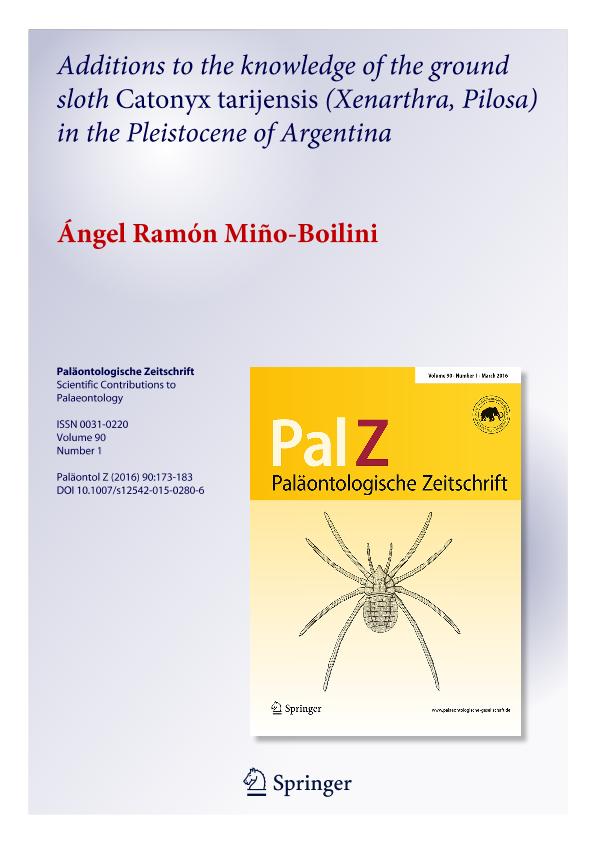Mostrar el registro sencillo del ítem
dc.contributor.author
Miño Boilini, Ángel Ramón

dc.date.available
2017-10-25T18:40:06Z
dc.date.issued
2015-12
dc.identifier.citation
Miño Boilini, Ángel Ramón; Additions to the knowledge of the ground sloth Catonyx tarijensis (Xenarthra, Pilosa) in the Pleistocene of Argentina; Springer Heidelberg; Palaeontologische Zeitschrift; 90; 1; 12-2015; 173-183
dc.identifier.issn
0031-0220
dc.identifier.uri
http://hdl.handle.net/11336/27096
dc.description.abstract
Quaternary Scelidotheriinae (Mammalia, Xenarthra, Mylodontidae) are represented by three genera: Scelidotherium Owen, Valgipes Gervais, and Catonyx Ameghino. The genus Catonyx includes three species of ground sloths: C. cuvieri (Lund), C. tarijensis (Gervais and Ameghino), and C. chiliensis (Lydekker). Catonyx tarijensis and C. chiliensis were present during the Quaternary of Argentina. The aim of this contribution is to improve the knowledge of C. tarijensis of Argentina from a morphological, systematic, and biostratigraphic point of view. The presence of C. tarijensis is recorded in the Ensenadan–Lujanian South American Land Mammal Ages (SALMAs) (Early Pleistocene–Late Pleistocene) of Buenos Aires Province, in the Lujanian SALMA (Late Pleistocene) of Corrientes Province, and in the Pleistocene of Córdoba and Salta Provinces. Outside Argentina, this species is recorded in the Late Pleistocene of Bolivia and Uruguay.
dc.description.abstract
.Quartäre Scelidotheriinae (Mammalia, Xenarthra, Mylodontidae) sind durch drei Gattungen vertreten: Scelidotherium Owen, Valgipes Gervais und Catonyx Ameghino. Die Gattung Catonyx beinhaltet drei Arten von Faultieren: C. cuvieri (Lund), C. tarijensis (Gervais und Ameghino) und C. chiliensis (Lydekker). C. tarijensis und C. chiliensis sind aus dem Quartär Argentiniens bekannt. Das Ziel dieser Mitteilung ist es, die Kenntniss von C. tarijensis aus Argentinien in Hinsicht auf ihre Morphologie, Systematik und Biostratigraphie zu verbessern. Die Art C. tarijensis ist aus den Ensenadan - Lujanian South American Land Mammal Ages (SALMAs) (frühes bis spätes Pleistozän) der Provinz Buenos Aires, der Lujanian SALMA (spätes Pleistozän) der Provinz Corrientes und dem Pleistozän der Provinzen Córdoba und Salta bekannt. Außerhalb Argentiniens wurde diese Art bisher im Pleistozän von Bolivien und Uruguay gefunden
dc.format
application/pdf
dc.language.iso
eng
dc.publisher
Springer Heidelberg

dc.rights
info:eu-repo/semantics/openAccess
dc.rights.uri
https://creativecommons.org/licenses/by-nc-sa/2.5/ar/
dc.subject
South American
dc.subject
Systematic
dc.subject
Quaternary
dc.subject
Scelidotheriinae
dc.subject
Mammalia
dc.subject.classification
Oceanografía, Hidrología, Recursos Hídricos

dc.subject.classification
Ciencias de la Tierra y relacionadas con el Medio Ambiente

dc.subject.classification
CIENCIAS NATURALES Y EXACTAS

dc.title
Additions to the knowledge of the ground sloth Catonyx tarijensis (Xenarthra, Pilosa) in the Pleistocene of Argentina
dc.type
info:eu-repo/semantics/article
dc.type
info:ar-repo/semantics/artículo
dc.type
info:eu-repo/semantics/publishedVersion
dc.date.updated
2017-10-04T14:50:47Z
dc.identifier.eissn
1867-6812
dc.journal.volume
90
dc.journal.number
1
dc.journal.pagination
173-183
dc.journal.pais
Alemania

dc.journal.ciudad
Heidelberg
dc.description.fil
Fil: Miño Boilini, Ángel Ramón. Consejo Nacional de Investigaciones Científicas y Técnicas. Centro Científico Tecnológico Conicet - Nordeste. Centro de Ecología Aplicada del Litoral. Universidad Nacional del Nordeste. Centro de Ecología Aplicada del Litoral; Argentina
dc.journal.title
Palaeontologische Zeitschrift

dc.relation.alternativeid
info:eu-repo/semantics/altIdentifier/doi/http://dx.doi.org/ 10.1007/s12542-015-0280-6
dc.relation.alternativeid
info:eu-repo/semantics/altIdentifier/url/https://link.springer.com/article/10.1007%2Fs12542-015-0280-6
Archivos asociados
